
views
Feeding Your Cat

Give your cat quality food. Canned and dry food are both fine as long as the food includes mostly animal protein and not a lot of filler. While dry food tends to be better at keeping cats' teeth clean, it can also dehydrate them as cats have a low thirst drive. If you're unsure of what to feed your cat, discuss food with your cat's veterinarian. They'll suggest what to feed your cat based on their specific nutritional needs.

Provide age-appropriate cat food. When your cat is young, feed them kitten food, which contains more fat and protein for their growing mind and body. As the cat ages, feed them food that gives them complete nutrition without giving them so much that they become overweight. When your cat gets older, you may need to transition them onto senior food, which provides the type of nutrition that geriatric cats need. Never make sudden food changes for your cat. Transition your cat gradually from one food to another.

Give a long-haired cat hairball-preventing cat food. If you have a long-haired cat, it is a good idea to give them hairball-preventing food, especially if they have a history of choking up hairballs. In most cases, this type of food helps to prevent hairballs by increasing the amount of fiber your cat is getting. Fiber increases the rate of digestion and moves food and hair through the digestive tract more effectively. Ask your veterinarian which hairball-preventing food is best for your cat. They may suggest a food that will not only fulfill your cat's nutritional needs, but also prevent hairballs.

Feed your cat two or three times a day. The amount of food you give it will depend on the size of your cat. Look at the food packaging and follow the directions for portion sizing, which is usually based on your cat's size and age. Cats who eat too quickly should be fed smaller, more frequent meals. Discuss portion size and feeding schedule with your veterinarian. They may have suggestions based on your cat's specific dietary needs so that you can keep your cat at a healthy weight. If you notice your cat rapidly gaining weight, talk to your vet. Being overweight can cause major health complications in cats, including diabetes and joint pain.
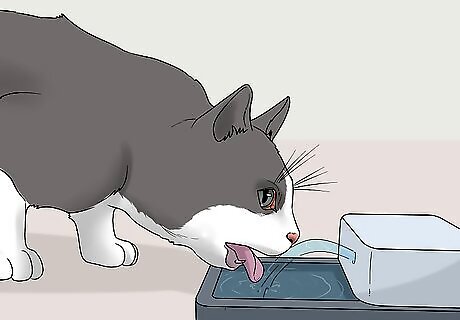
Give unlimited access to drinking water. It is very important to provide your cat with clean water at all times, as cats are prone to dehydration and kidney problems. Put the water in a clean, small bowl and replace it daily, so that the water is appealing for the cat to drink. Try a cat drinking fountain. The recirculating water stream may draw your cat's attention and encourage them to drink more. Keep the cat's water away from their litter box and food. Cats generally see water near these areas as contaminated. If your cat tends to only drink from unattended glasses, consider keeping a glass filled with fresh water on the table or counter that's just for your cat! Cats can be picky. If your cat is not drinking water, the water might not be fresh, or the bowl, fountain, or glass might be dirty.
Providing for Safety, Comfort, and Hygiene

Provide identification. Once you bring a cat home and name them, get them some identification. This can be in the form of a tag on their collar, but you can also get them microchipped at your veterinary office. Even if you plan on raising the cat to live indoors, having identification is important -- remember, if they get out, they will have no experience finding their way home. Your cat's collar tag should include their name and your phone number. Keep this phone number up to date, so that someone who finds your cat can contact you easily. Be sure to secure the tags to a collar with a quick-release buckle. That way, if your cat gets caught on something, the collar can break off without harming the cat. Having both a collar and a microchip would be best. The collar would allow for quick identification, while a microchip will be a backup in case the collar gets lost.
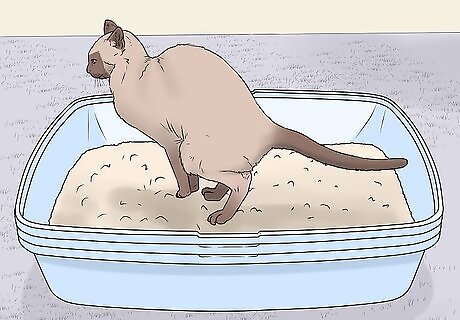
Provide and teach the use of a litter box. When raising a cat, you will need to teach them to use a litter box. For most cats, this is a relatively easy process. Once you bring a cat home, keep them contained in a small space with food, water, a bed, and its litter box. The cat may naturally head towards the litter box to go to the bathroom, as they are naturally clean animals who like to pick specific bathroom areas. Keep the litter box in an area that is easily accessible and close to your cat's daily activity. This will help ensure that the cat actually uses it.
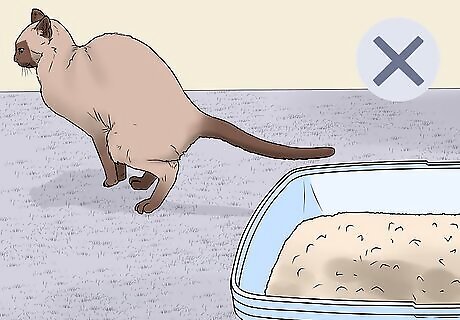
Keep trying if litter box training is problematic. If the cat doesn't use the litter box automatically, move any feces or urine into the litter box and clean the areas where the cat went to the bathroom outside of the box. If the cat smells feces and urine in the litter box, they will know that is where they should go. If your cat approaches the litter box, but refuses to go in it, try a different litter. Your cat might understand that they need to use the box, but they might not like the texture or scent of the litter. Cats are intelligent animals. If your cat continues to refuse to use the litter box, consult your veterinarian; there could be an underlying health issue.

Clean the litter box regularly. To ensure that your cat uses their litter box, you should make sure to keep it clean and tidy. Remember to remove solids daily. Once a week, fully empty and clean the box, and refill it with fresh litter. If you do not clean your cat's litter box regularly, they are likely to find somewhere else to go to the bathroom.

Give your cat a cozy place to sleep. When raising a cat be sure to give them a cozy place where they can take a nap or just get some alone time. Typically, this is done by giving them a bed in a quiet and warm corner. This can be difficult to achieve if you live in a hectic or crowded home, but your cat may even pick the spot themself and all you have to do is provide the cushioning. Many cats love warm, sunny spots with views of the outdoors. Even on cold days, the feeble sunlight will be enough to suit your cat's needs. Some cats like to rotate their sleeping places. One month they may like to sleep next to the window, while another month they may prefer to nap under the bed! Don't force your cat to sleep in a specific spot. This will only make the cat averse to the location and avoid it.
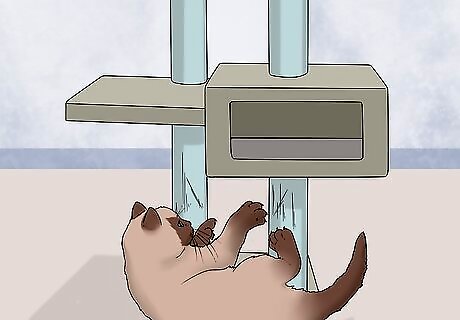
Provide a place to scratch. All cats need to scratch once in a while in order to keep their claws healthy and agile. In order to allow them to do this without destroying your furniture, get them a scratching post or scratching pad. If your cat likes to scratch a lot, you may even need to buy or make one for every room. Teach your cat to use it by placing it in front of their favorite scratching spot. Place your cat's paws on it, or scratch it yourself! Make scratching posts and scratching pads more attractive by rubbing catnip on it. Each cat is different. If your cat doesn't like a scratching post, try a scratching mat or a cardboard scratching pad.
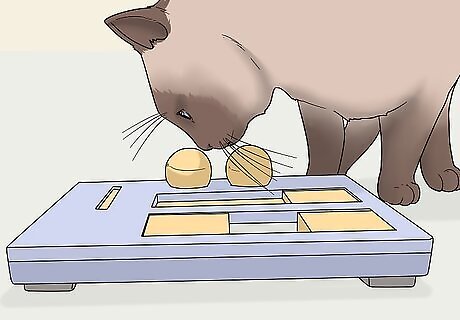
Keep your cat inside. Try to raise a cat to stay indoors, especially if you live in a city. Living indoors greatly increases their lifespan due to lower risks for disease, injury or abuse. It also helps keep wildlife in your area , such as birds, safe and healthy. For entertainment for an indoor cat, provide boxes, cat toys, and sunny window perches for them to lounge in. You may also consider having at least two cats, so that they can keep each other occupied when you are away. Make sure that all doors are kept closed and that all windows and window screens are secure if you are trying to keep your cat indoors.
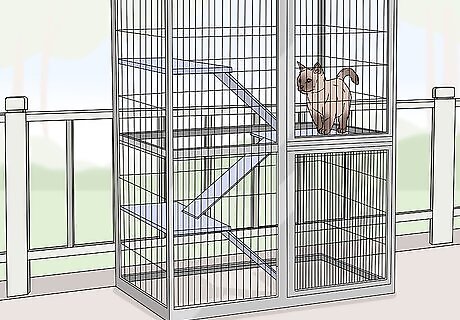
Build your cat an enclosed patio. If you really want your cat to experience the sights and smells of the outdoors, consider building them a "catio," which is a cat patio. This is an enclosed outdoor area that is typically attached to your home, and which allows your cat to get some outdoor time without letting it roam freely. A catio allows your cat the stimulation of being outside but limits their ability to get lost or kill wildlife in your area.
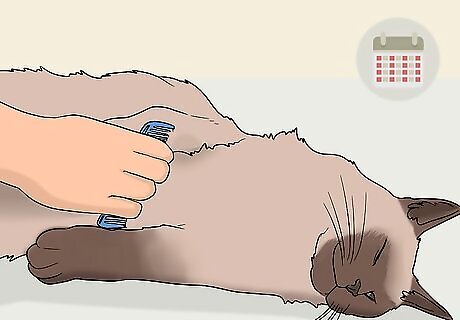
Brush your cat regularly. Depending on the breed, you may need to brush your kitty more often, but all breeds (except the Sphynx) need to be brushed at least weekly. For example, Persian cats need brushing 3 to 4 times a week but American shorthair cats only need to be brushed once a week. Weekly brushing eliminates tangles and reduces spare hair that would rub off on furniture or floors, or form hairballs in your cat. Cats don't need baths unless they get into something foul and can't clean themselves off. The exception to this is Sphinx cats, which are bald and need bathing once a week to keep skin oils under control.
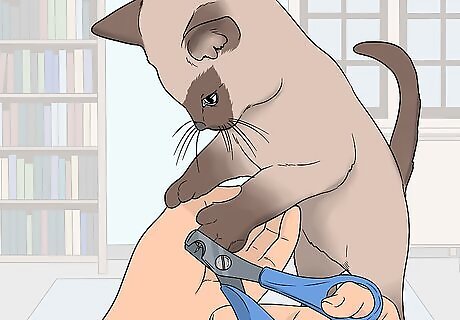
Remember to clip your cat's claws. Choose nail clippers made for cats, which come in a guillotine type or a scissors type, or human nail clippers. Put the clippers perpendicular to the claws. Trim only the tip of the nail. The quick of the nail, which is the back part of the nail with a blood vessel in it, should not be cut. Begin clipping your cat's claws every week when they are young. This will get them used to the process and will make them less resistant to it when they become an adult. Trimming a cat's nails is particularly important if the cat does not regularly go outside, where they might wear down the nails with vigorous activity. If you are having troubles trimming your cat's claws, ask a veterinarian or cat groomer to show you how to do it.
Getting Veterinary Care
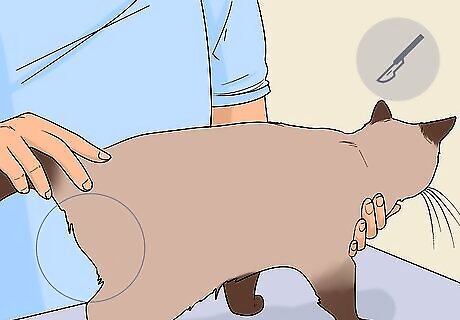
Have your cat sterilized (desexed). Most cats should be spayed or neutered at an early age. The cat will be tamer and desexing decreases the risk of your cat developing certain cancers, such as uterine tumors in female cats. Most vets will not spay or neuter your kitty until they weigh about two pounds, so discuss the right time with your vet. Another benefit is that you won't have to deal with your female cat going into heat, or your male cat spraying indoors and roaming outside to look for a mate. The only cats who shouldn't be fixed are those who are purebred and are intentionally being used for breeding by experienced and ethical breeders. Sterilization is a more expensive alternative allows your cat to keep their hormones. In this case, you should have both a sterilized male and female cat so that they can satisfy each other's needs. Sterilized cats will still go through heats and will maintain normal cat behavior, such as roaming (if there is no mate in the house) or spraying (not all full male cats spray).
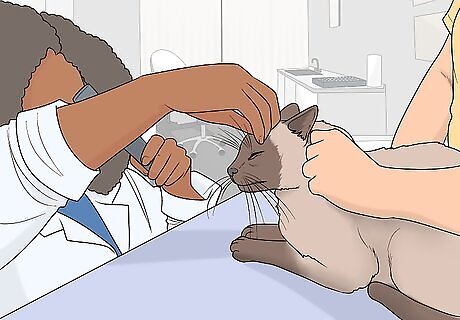
Take your cat in for preventative veterinary exams. In order to raise a cat properly, you need to provide them with regular veterinary care. When a cat is young, it typically only needs to have an annual exam, in which the veterinarian checks their overall health and updates any vaccines or medications that they need. Once your cat gets old, they will likely need veterinary checkups more often, usually every six months. Veterinary checkups may seem like a waste of money if your cat is generally healthy, but they can actually save you money in the long run. Finding a health problem early on and getting early treatment can reduce costs, along with your cat's pain and suffering.

Keep up to date with preventative medication. When bringing your cat in for a checkup, discuss flea medications and vaccinations with your veterinarian. For flea medications, they will most likely recommend a regular flea repellent treatment, such as Frontline and Trifexis, that you will apply at home. It is important to keep up to date with this medication so that your cat does not experience a flea infestation. Get the vaccinations and vaccination boosters that your veterinarian suggests. They will make suggestions based on your cat's risk of exposure and the health history. The veterinarian may suggest vaccinations for panleukopenia, herpesvirus, calicivirus, rabies, feline leukemia, chlamydiosis, infectious peritonitis, immunodeficiency, bordetella, and giardiasis.
Giving Affection and Attention

Show your cat love and affection. You can do this by holding it in your lap and petting it for a little while every day. You can do this by playing with them and giving them uninterrupted attention for at least a little while every day. Whatever you do, make sure that your cat knows they are loved and that they're an important member of your family. Many cats only want attention occasionally, and will ask for it when they want it. If your cat is like this, give them some petting and attention when they ask for it. Your cat's requests may not always come when you want them to, but remember that your cat deserves a bit of uninterrupted attention every day.

Socialize your cat. In order to raise a happy and well adjusted cat, begin socializing them when they are very young. Introduce your cat to a wide variety of people beginning when they are a small kitten, so that they know this is a normal part of life. Exposing them to a wide variety of people, and keeping those interactions positive, will make it more likely that the cat is friendly and interested in new people and animals when older, instead of being scared or aggressive towards new people. Socialization can include exposing your cat to a wide variety of noises and situations. For instance, if you expose a kitten to a vacuum cleaner early on in their life, they are less likely to be fearful of it as an adult.

Provide your cat with mind-stimulating toys. All cats need some mental stimulation every day. This is especially true when cats are kittens and their minds are developing. This can be provided, in part, by giving them stimulating toys to play with while they're alone. These toys could include motorized cat toys that they can chase around, but it can also include simpler toys, such as toy mice or balls with bells in them. You may need to bring home a variety of toys before you find the right one. Try out the toys with your cat one at a time until you find the one it prefers. Cats can get bored with toys that they have played with for a long time. Provide new and exciting toys on a regular basis. Your cat's preferences may change with age. A cat who liked a squeaky mouse toy as a kitten may prefer string as an adult.
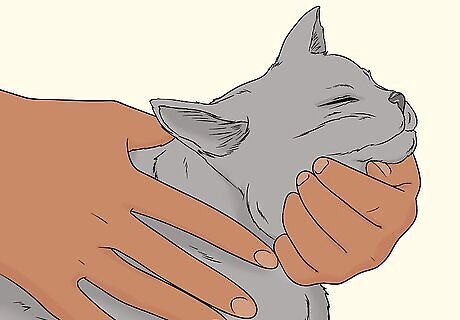
Interact with your cat daily. In addition to giving your cat toys for them to play with on their own, spend quality time playing with your cat every day. Spend quality interactive time with your cat in order to develop their mind and personality. Use a feather on a string or a laser pointer to get the cat to run around and leap into the air. Throw little toys for the cat to chase and play other games that they enjoy. This interaction will likely be more stimulating to the cat than playing on their own. If your cat has a long enough attention span, you can even try to train them to do things, such as tricks you would normally teach a dog.



















Comments
0 comment